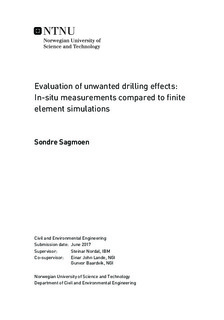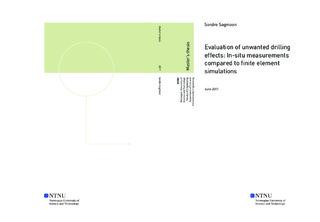| dc.description.abstract | In the latter years, there has been an increasing interest in unwanted settlements and damages occurring on neighboring infrastructure due to foundation work. There has been a research project going from 2012 to 2015 focusing on problems regarding this, called BegrensSkade. This research project has amongst other causes identified drilling for piles and anchors as a cause to unwanted settlements and damages. Several negative effects due to drilling have been proposed, amongst them a local suction around the drill bit and mechanical disturbance around the pile-/anchor casing. These two effects are both considered to create settlements in the adjacent soil, either as loss of soil due to excess flushing or as direct disturbance (straining) and following reconsolidation of the surrounding soil.
The first effect can be related to the Venturi effect, which is an effect related to Bernoulli s equation on fluid flow. The Venturi effect implies that when constraining the cross-section of a fluid flow, the velocity will increase and due to energy and mass conservation, the pressure will fall. This creates a suction at the constraint. This effect is assumed to occur when drilling in permeable non-cohesive soil layers, such that both excess water and soil is flushed out through the casing when drilling with air or water as driving force and flushing fluid.
The second theory is a continuation of the known volume displacement and straining due to pile driving. It is assumed that some straining can occur on the soil adjacent to the pile, and this will further lead to volume reduction when reconsolidation. This theory, as opposed to the Venturi effect, is a secondary effect due to the time duration of reconsolidation.
These effects have been evaluated trough case studies on two recent construction projects, the Hobøl River bridge and Gladengveien 10, and implementation in Finite Element Analysis. From pore pressure measurements and settlement measurements in the two projects, considerations on what is most likely to have caused the measurements, have been made. The effects have further been tried implemented in the FE program PLAXIS, to see what parameters one could manipulate to get the measurement results resembling the two cases.
The straining and reconsolidation has been implemented as a volume reduction in a zone adjacent to the casing. The results from FEA shows that a considerable large zone must be effected to create settlements near the measured settlements. As drilling piles is considered a cautious pile installation technique, it is considered that the applied strains and size of effected zone is too large to be a reasonable explanation. The results from the FEA on the Venturi effect is however more interesting. As the Venturi effect is considered a temporary effect, it could better explain the temporary pore pressure reductions seen in the projects. Through the FEA, it is observed that the large sudden drop in pore pressure could occur when varying some of the parameters.
The parameter analyses on the Venturi effect shows that the boundary conditions in the FE model is the most interesting when evaluating the pore pressure distribution in radial direction. Relating this to in-situ conditions, the key points are the hydrogeological conditions in the firm masses between a clay layer and the bedrock. This is considered the most interesting topic for further investigations regarding the risk of loss of soil mass around the drill bit.
The representative suction in PLAXIS is modelled as a drain, such that this action will only affect the groundwater. Thus, the relationship between groundwater flow and possible loss of soil masses should be given further interest. The results in PLAXIS show that the flow gradients close to the applied drain are very large, and this could also be subject for further investigations. | |

